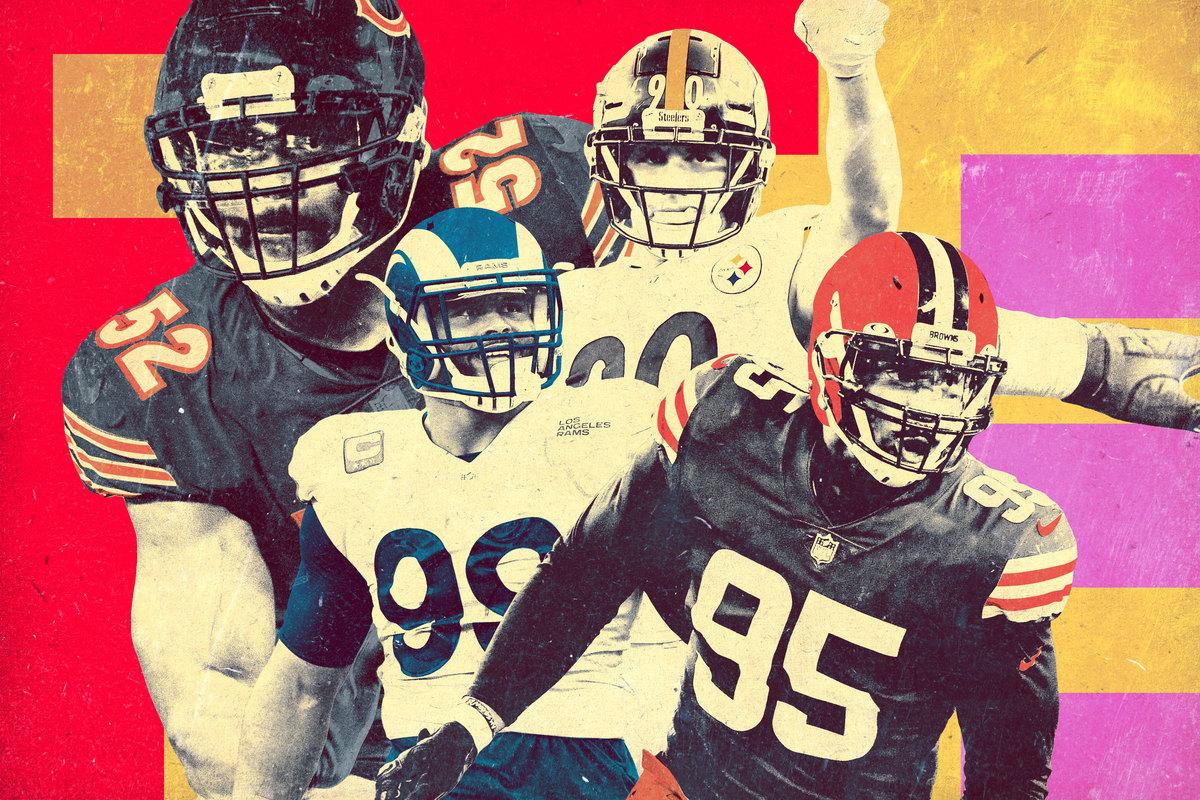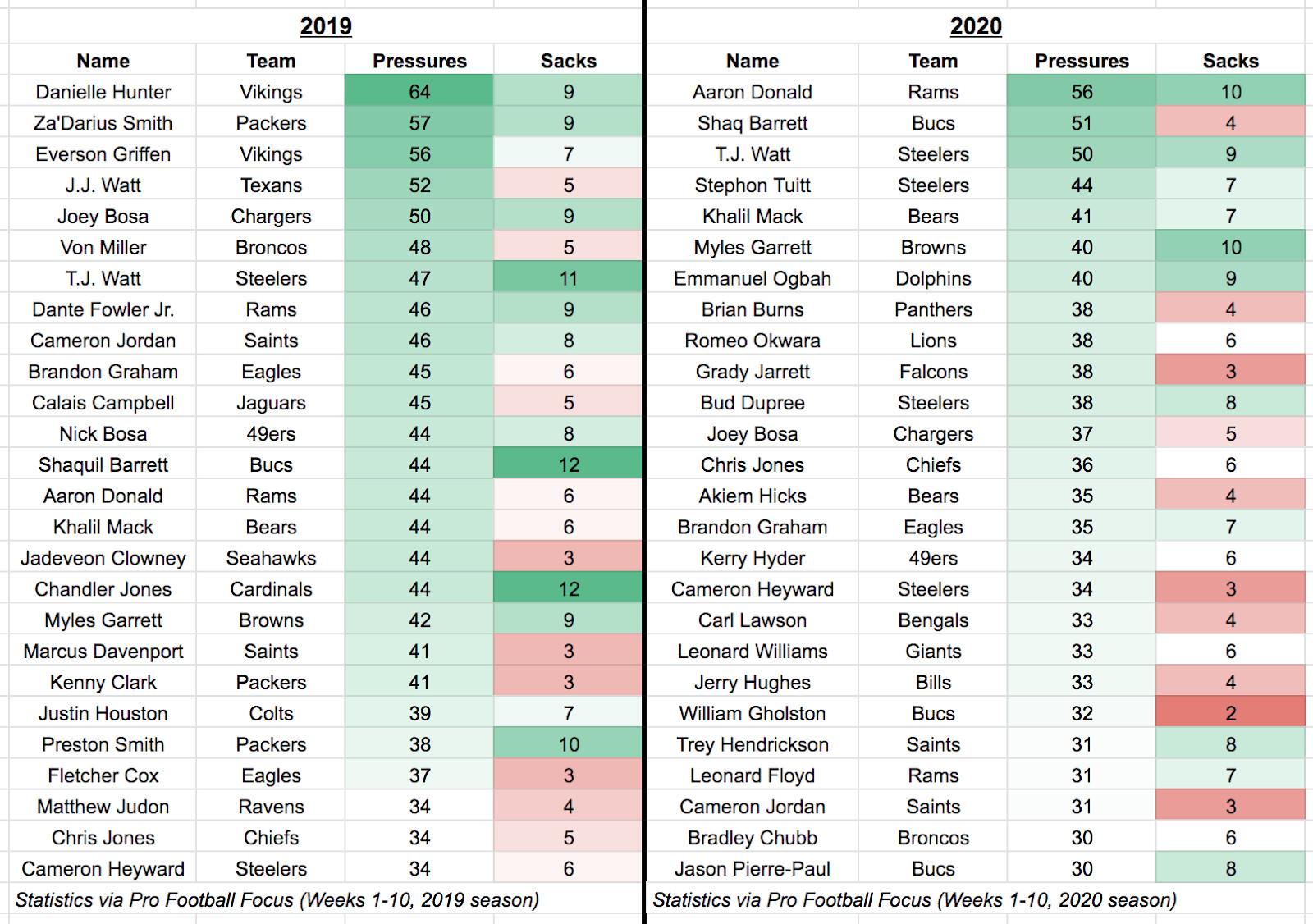
This year, the NFL has driven home a point that was already pretty clear: Offenses are the league’s heroes. In the past few seasons, we have fawned over wild, high-scoring games like the Chiefs-Rams Monday Night thriller, but lamented low-scoring contests, such as Super Bowl LIII. That isn’t to say defenses are the villains. Defenses are more like antiheroes. The purpose of defense is to prevent scoring—and so it’s just not as fun to watch good defenses as it is good offenses.
Unfortunately for defenses, the NFL isn’t scripted like The Sopranos. Instead, the story has always been about the league’s dynamic offenses and especially how it can get viewers to rejoice over star quarterbacks. That said, maybe it wasn’t too surprising when the NFL’s competition committee asked officials to de-emphasize offensive holding calls this offseason. As a result, scoring and offensive yardage have skyrocketed across the league and quarterbacks are producing at record-setting rates.
“(Penalties are) not as important as what the NFL likes and what the audience likes,” NFL senior vice president of officiating, training, and development Walt Anderson told NFL.com’s Ian Rapoport following a high-scoring Week 1. “People want to see penalties that need to be called, not penalties that are ticky-tack.”
So far, the league’s decision is favoring its intended heroes. But that doesn’t mean its antiheroes aren’t continuing to overcome obstacles. In a season dominated by offense, pass rushers have defined the NFL’s most successful defenses and headline the Defensive Player of the Year race. The odds-on favorites to capture that award are Aaron Donald, T.J. Watt, Myles Garrett, and Khalil Mack—all players who make their living pressuring the quarterback. Their jobs are more difficult than ever, but their performances have anchored some of the league’s best defensive units and lifted some of their teams into legitimate playoff contention.
Considering the league’s passing boom, the importance of sacks can’t be overstated. Other than turnovers, sacks are the most valuable, game-changing play a defense can make, but offenses in recent seasons have adopted various spread offensive schemes and are more heavily incorporating play-action calls to prevent pass rushers from affecting quarterbacks. The NFL’s de-escalation of offensive holding calls has helped mitigate the frequency of sacks as well. Entering Week 11, the average NFL sack rate has dropped from 6.7 in 2019 to 5.8 this year, according to Pro Football Reference, for the lowest mark since 2016.
Earlier this week, the Chicago Tribune’s Brad Biggs asked which is more essential to building an elite defense: an elite secondary or an elite pass rush? A defense can’t be elite without both, however a veteran defensive coach quoted in the story explained that attaining premier defensive backs should be valued more because they can shut down elite receivers—and because pass rushers can’t affect the game as much as they might have in years past, considering run-pass options and other college pass concepts that neutralize pass rushers have fully infiltrated the NFL.
“Let’s say there are 30 throws in a game and it’s RPO, quick game, boots and sprint-outs on 18 of those passes,” the coach told Briggs. “Now you’re telling that pass rusher, the guy you’ve poured a ton of money into, here are 12 plays — go get the quarterback. … It’s hard enough to rush the quarterback as it is. Add on top of it they’re not calling holding on offensive linemen this season. Now you might only have a dozen chances a game to truly get after him. Good luck.”
Based on how pressure stats across the league have dipped from last season, it’s apparent pass rushers aren’t having as much luck as before. According to Pro Football Focus, at this point last season, there were five players with at least 50 pressures and 20 players with at least 40 pressures through Week 10. This season, there are three players with at least 50 pressures and seven players with at least 40 pressures in that span.

The present circumstances make the work of the NFL’s best pass rushers even more impressive. Donald, a two-time Defensive Player of the Year, has dominated all season, despite being deployed as an interior lineman and routinely facing double teams. According to Pro Football Focus, Donald’s 56 pressures lead the NFL and his 10 sacks are tied with Browns defensive end Myles Garrett for the most in the league. Donald’s dominance is a major reason why the Rams are in contention for a playoff spot, leading the no. 8 defense in Football Outsiders’s DVOA metrics.
Eight of Football Outsiders’s top-10 defensive units entering Week 11 anchor teams in the thick of their conferences’ respective playoff races. And many of them boast dominant pass-rushing units, with some featuring one or more of the league’s top pass-rushing defensive linemen. The Bucs (first in defensive DVOA) boast pass rusher Shaquil Barrett, who’s registered 51 pressures (second), 43 hurries (first), and four sacks this season. The Steelers are the NFL’s last remaining undefeated team despite a league-average offense (16th in DVOA). Pittsburgh’s play has been best defined by the play of its star-studded defensive front this year, starring Watt, Cameron Heyward, Bud Dupree, and Stephon Tuitt. Watt, who entered the week as several oddsmakers’ favorite to win DPOY, is third in the league in pressures and tied for third with Emmanuel Ogbah of the Dolphins with nine sacks. Tuitt, an interior lineman, has 44 pressures (fourth) and has seven sacks (tied for ninth); Dupree, an edge player, has tallied 38 pressures (tied for eighth) and eight sacks (tied for fifth); Heyward, an interior lineman, has 34 pressures (tied for 16th) and three sacks (tied for 10th among interior DL). According to Pro Football Reference, Pittsburgh’s league-best 35 percent pressure rate (which accounts for hurries, knockdowns, and sacks per dropback) leads the league in pressure rate by nearly 8 percent, a significant margin.
Even some teams with struggling offenses have been boosted by defensive performances reliant on standout pass rushers. Two teams entering Week 11 are .500 or better despite having negative point differentials: the Bears (5-5, minus-18 point differential) and the Browns (6-3, minus-28 point differential). Neither team has been consistent offensively throughout the season. Chicago has scored 17 points or fewer in five games (1-4) and ranks 29th in offensive DVOA; Cleveland has scored 10 points or fewer four times (1-3) and ranks 17th in offensive DVOA. The Bears’ offense has been among the worst in the NFL, but they jumped out to a strong start and remained competitive in games thanks to their defense, led up front by Mack and nose tackle Akiem Hicks. Mack, a onetime DPOY, is fifth in pressures (41) and tied for ninth in sacks (seven); Hicks’s 35 pressures are tied for 14th most and his four sacks are tied for eighth among interior DL. Garrett has been a force for Cleveland, which is in contention to make the playoffs for the first time since the 2002-03 season. Garrett, the 2017 no. 1 overall pick, has generated 40 pressures (tied for sixth), 10 sacks (tied for first), forced four fumbles, and has made two fumble recoveries in crucial moments.
Overall, pass-rushing success is down across the league, so the impact of successful pass rushers is that much more meaningful. Last year, Patriots cornerback Stephon Gilmore broke a streak of five consecutive seasons in which a defensive lineman or outside linebacker captured Defensive Player of the Year honors. But despite the odds being stacked against these players perhaps more than before, it looks more than likely that this award will ultimately go to one of the game’s top pass rushers. They will have certainly earned it.